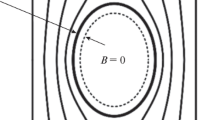Abstract
As early as the 1930s, experiments, particularly those by Leo Vasilyevich Shubnikov in Kharkov in Soviet Ukraine, showed that the ideas of that time in the field of superconductivity needed to be expanded. Shubnikov had built a low-temperature laboratory there early on, in which experiments could also be carried out with liquid helium. (However, Shubnikov’s many foreign contacts became his undoing during the Stalin terror of the time.
Access provided by Autonomous University of Puebla. Download chapter PDF
Similar content being viewed by others
As early as the 1930s, experiments, particularly those by Leo Vasilyevich Shubnikov in Kharkov in Soviet Ukraine, showed that the ideas of that time in the field of superconductivity needed to be expanded. Shubnikov had built a low-temperature laboratory there early on, in which experiments could also be carried out with liquid helium. (However, Shubnikov’s many foreign contacts became his undoing during the Stalin terror of the time. Stalin had him arrested and shot on November 10, 1937, after 3 months in custody).
Electrical and magnetic measurements, especially on superconducting alloys, had shown behavior that was not understood at that time. Especially the question of the relative size of the coherence length \(\xi\) and the magnetic penetration depth \(\lambda_{{\text{m}}}\) came into focus. The young theoretical physicist Alexei A. Abrikosov at the University of Moscow made the decisive breakthrough at that time. He was a friend of Nikolay Zavaritskii, who wanted to verify the predictions of the Ginzburg–Landau theory at the Kapitza Institute for Physical Problems by means of experiments on superconducting thin films. Until then, the only case in which the length difference ξ–λm, and thus also the wall energy during domain formation in superconductors, was positive, had been considered.
Abrikosov and Zavaritskii now seriously discussed for the first time the possibility that the length difference can also become negative if the coherence length \(\xi\) is smaller than the magnetic penetration depth \(\lambda_{{\text{m}}}\). Based on the Ginzburg–Landau theory, Abrikosov calculated the critical magnetic field for this case as well. He was able to prove that this was the only way to achieve good agreement with Zavaritskii’s experimental data for particularly carefully prepared thin films. Abrikosov and Zavaritskii were now convinced that they had discovered a new type of superconductor, which they called the “second group.” Today, this group is called type II superconductors (with \(\xi \; < \;\lambda_{{\text{m}}}\)), while the superconductors with positive wall energy are called type I superconductors (with \(\xi > \lambda_{{\text{m}}}\)).
His further theoretical analysis of type II superconductors using the Ginzburg–Landau theory led Abrikosov to discover a novel state in the presence of a magnetic field: The superconductor may be permeated by a regular lattice of individual magnetic flux quanta. Abrikosov had found the flux line lattice and the so-called mixed state. How revolutionary Abrikosov’s discovery was at that time can be seen from the fact that his doctoral supervisor, Lew Dawidowitsch Landau, did not agree with the novel result. Only after the American Richard Phillips Feynman, only a few years later, also discussed quantized vortex lines in rotating superfluid helium, did Landau give his consent. In this way, the publication of Abrikosov’s work, which was completed in 1953, was delayed by several years.
The magnetic flux quanta that permeate the superconductor like filaments are generated by superconducting ring currents, which generate a spatially confined, local magnetic field like a magnet coil. We will come back to the magnetic flux lines in Chap. 5.
In Fig. 4.1, we show once again the magnetic flux density B inside a type I superconductor and its magnetization M as a function of the applied magnetic field H for the case of a geometry with a vanishing demagnetization coefficient D. We see the perfect diamagnetism with \({\text{B}} = 0\) below the critical magnetic field HC and the linear increase of − 4πM with increasing H.
The superconducting mixed state with the magnetic flux line lattice exists in the region of the magnetic field above the “lower critical magnetic field” HC1 < HC and below the “upper critical magnetic field” HC2, i.e., in the region HC1 < H < HC2. Below HC1, the Meissner-Ochsenfeld effect still applies. In Fig. 4.2, this behavior is shown schematically (again under the assumption D ≈ 0).
The first experimental proof of the magnetic flux line lattice was performed by elastic neutron diffraction in 1964 on the basis of the interaction of the magnetic moment of the neutrons with the magnetic field gradients of the mixed state. A particularly impressive experimental confirmation was achieved in 1967 by Uwe Essmann and Hermann Träuble using the so-called Bitter technique. They sprinkled a fine ferromagnetic powder onto the surface of the superconductor. There the powder is attracted by the points where the magnetic flux lines reach the surface. The small heaps of powder that are formed thus decorate the individual flux lines (Fig. 4.3).
Superconducting mixed state with the lattice of quantized magnetic flux lines proposed by Abrikosov for the first time. a Schematic diagram. A total of nine magnetic flux lines are shown, each magnetic flux line being surrounded by superconducting ring currents. b Experimental proof of the Abrikosov lattice of magnetic flux lines for a 0.5-mm thick plate of superconducting niobium by decoration with the Bitter technique. The many dark dots mark the places where the individual magnetic flux lines penetrate the surface of the superconducting plate. (U. Essmann)
Author information
Authors and Affiliations
Corresponding author
Rights and permissions
Copyright information
© 2021 Springer Fachmedien Wiesbaden GmbH, part of Springer Nature
About this chapter
Cite this chapter
Huebener, R.P. (2021). Type II Superconductors, Abrikosov Vortex Lattice, Mixed State. In: History and Theory of Superconductors. essentials(). Springer, Wiesbaden. https://doi.org/10.1007/978-3-658-32380-6_4
Download citation
DOI: https://doi.org/10.1007/978-3-658-32380-6_4
Published:
Publisher Name: Springer, Wiesbaden
Print ISBN: 978-3-658-32379-0
Online ISBN: 978-3-658-32380-6
eBook Packages: Physics and AstronomyPhysics and Astronomy (R0)







